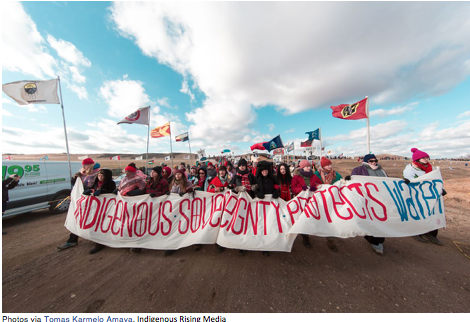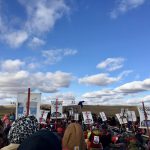Defending the Sacred in a Militarized Police State at Standing Rock

Alexis Stanley
Alumna, Former Advocate for Community Engagement ’15
On the evening of Sunday, November 20th I was returning home after a week up in Standing Rock, North Dakota. This was the same night unarmed water protectors, just north of the main Oceti Sakowin camp attempted to remove the cement barricades and burned cars blocking the public 1806 Highway. Water protectors were met with water cannons, tear gas, rubber bullets, and concussion grenades. Despite this being outright inhumane and completely unnecessary it does speak to cycle of violence inflicted upon Native lands and communities since settlers first arrived.
This fight to protect water and defend sacred sites has been met with a corporate police state military invasion of a sovereign tribal nation. Dakota Access is protected and supported by North Dakota’s National Guard, Morton County Sheriff’s Department and State police. Behind their razor wire barricades, humvees, tactical security walls, snipers, and riot gear outfits, we see the ongoing willingness to exert violence and force guided by colonialism.
I had been following the social media coverage rather closely in the months leading up to my arrival in Standing Rock. While I thought I went in with little expectations, I was still surprised to see what was actually taking place on the ground. There was a heavy surveillance presence throughout the entire area. Drones consistently flew above day and night, along with several helicopters and small planes. Atop rolling grassy hills are large flood lights that Dakota Access shines directly into the camps at night. All of these intimidation tactics are to instill fear, paranoia, and disrupt the work being done on the frontline. To me, this militarized police state at the hands of corporate interests shows that even with all the armor and disposable resources, they are still terrified to go head to head with unarmed Natives and their allies that are led by prayer and unwavering stance to protect Mother Earth.
There is very heavy emphasis when inside the camp that this is prayer and resistance driven camp where drugs, alcohol and weapons absolutely have no place there. Throughout the entire camp, work is constantly being done, from construction, art, cooking, organizing, and ceremony. This isn’t Coachella. Snow has already arrived, and in the last several weeks people have been in hardcore preparation mode to be ready for the increasingly cold winter to come.
With Standing Rock being an indigenous centered space, I was still slightly surprised to see the majority of the camp to be non-Native. Based on my own observations, it was clear to see how even within the different sub-camps, with majority of the camp being with non-Native allies this presents a lot of questions and challenges. Allies are crucial in this fight to defend the water, but there is a need to continue to have open conversations on intentions and impacts in Native-led spaces where tribal leadership and wisdom may be new concepts for you but must be respected at the same time.

On Thursday, November 17th, a large group of us, water protectors, rolled out to Bismarck and Mandan, ND to rally outside a Federal courthouse demanding that President Obama take immediate action to stop the Dakota Access Pipeline from being constructed. We then proceeded to march and circle the Morton County Correctional Center where the Morton Country Sheriff is headquartered. Water protectors chanted to demand the release of Red Fawn Fallis, a water protector who is facing charges of attempted murder after authorities claimed she fired shots at law enforcement while she was being arrested during the October 27th raid on the Oceti Sakowin 1851 treaty land encampment. Some of local town “counter protestors” had plenty of choice words for us when participating in peaceful direct action, which was mostly comical, but unsettling all the same. It’s almost hard to conceptualize why they consider water protectors “terrorists” for standing their ground. When in turn, it was these same communities north of Bismarck who feverishly opposed the pipeline being constructed closer to their communities and would have threatened their water supplies, but their opposition wasn’t met with this strong of a military presence.
On Friday, November 18th, the International Indigenous Youth Council led a direct action at the barricade north of the Oceti Sakowin camp. Hundreds of water protectors and allies stood, sat, and knelt at the bridge to pray and stand in solidarity. In those moments, I felt connected to land we stood on, the water, and I felt calm and empowered to be alongside the protectors and allies defending our life source and sovereignty as indigenous peoples.
Being able to go up there and experience some of what is taking place on the frontlines is something that will always stick with me. I felt a personal calling to stand in solidarity largely because I grew up respecting, cherishing and understanding that water is sacred. My mother’s family is from the Navajo Nation, and in Navajo (Diné) something that has always resonated with me is “Tó éí ííńá át’é” which means “water is life”. Similarly, the Lakota way of saying this phrase is also “Mni Wiconi” which can be heard randomly exclaimed throughout the camps at Standing Rock as a way to get people pumped up. As a Diné woman, I embrace the notion that we are our ancestors prayers in the flesh, we are the seventh generation, and I support and stand with our relative who are putting it all on the line to protect our waters, our lands, and our people.





